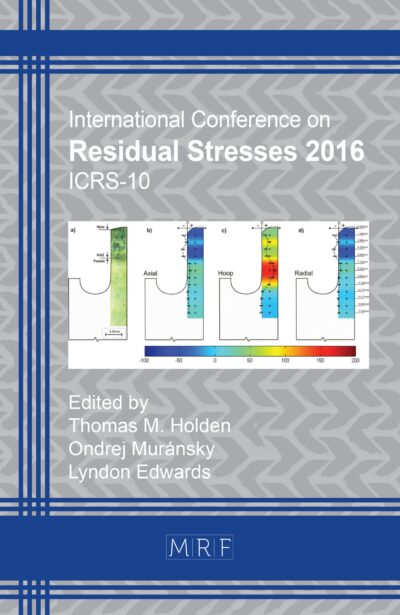Residual Stress Formation in Component Related Stress Relief Cracking Tests of a Welded Creep-Resistant Steel
M. Rhode, A. Kromm, D. Schroepfer, J. Steger, T. Kannengiesser
download PDFAbstract. Submerged arc welded (SAW) components of creep-resistant low-alloyed Cr-Mo-V steels are used for thick-walled heavy petrochemical reactors (wall-thickness up to 475 mm) as well as employed in construction of modern high-efficient fossil fired power plants. These large components are accompanied by significant restraints during welding fabrication, especially at positions of different thicknesses like welding of nozzles. As a result, residual stresses occur, playing a dominant role concerning so-called stress relief cracking (SRC) typically during post weld heat treatment (PWHT). Besides specific metallurgical factors (like secondary hardening due to re-precipitation), high tensile residual stresses are a considerable influence factor on SRC. For the assessment of SRC susceptibility of certain materials mostly mechanical tests are applied which are isolated from the welding process. Conclusions regarding the influence of mechanical factors are rare so far. The present research follows an approach to reproduce loads, which occur during welding of real thick-walled components scaled to laboratory conditions by using tests designed on different measures. A large-scale slit specimen giving a high restraint in 3 dimensions by high stiffness was compared to a medium-scale multi-pass welding U-profile specimen showing a high degree of restraint in longitudinal direction and a small-scale TIG-re-melted specimen. The small-scale specimens were additionally subjected to mechanical bending to induce loads that are found during fabrication on the real-scale in heavy components. Results show for all three cases comparable high tensile residual stresses up to yield strength with high gradients in the weld metal and the heat affected zone. Those high tensile stresses can be significant for cracking during further PWHT.
Keywords
Welding, Residual Stresses, Creep-Resistant Steel, Post Weld Heat Treatment, Stress Relief Cracking, 13CrMoV9-10
Published online 9/11/2018, 6 pages
Copyright © 2018 by the author(s)
Published under license by Materials Research Forum LLC., Millersville PA, USA
Citation: M. Rhode, A. Kromm, D. Schroepfer, J. Steger, T. Kannengiesser, ‘Residual Stress Formation in Component Related Stress Relief Cracking Tests of a Welded Creep-Resistant Steel’, Materials Research Proceedings, Vol. 6, pp 185-190, 2018
DOI: https://dx.doi.org/10.21741/9781945291890-29
The article was published as article 29 of the book Residual Stresses 2018
![]() Content from this work may be used under the terms of the Creative Commons Attribution 3.0 licence. Any further distribution of this work must maintain attribution to the author(s) and the title of the work, journal citation and DOI.
Content from this work may be used under the terms of the Creative Commons Attribution 3.0 licence. Any further distribution of this work must maintain attribution to the author(s) and the title of the work, journal citation and DOI.
References
[1] L. Antalffy, Metallurgical, design & fabrication aspects of modern hydroprocessing reactors, Weld. Res. Counc. Bull. 524 (2009) 77-115.
[2] K. Park et al., Post-weld heat treatment cracking susceptibility of T23 weld metals for fossil fuel applications, Mater. Des. 34 (2012) 699-706. https://doi.org/10.1016/j.matdes.2011.05.029
[3] K. Tamaki, J. Suzuki, H. Kawakami, Metallurgical factors affecting reheat cracking in HAZ of Cr-Mo steels. Proceedings of the Finnish-German-Japanese Joint International Seminar on Mechanical Approaches to New Joining Process (2004), 155-168.
[4] P. Nevasmaa, J. Salonen, Reheat Cracking Susceptibility and Toughness of 2% CrMoWVNb P23 Steel Welds, Weld. World. 52(3) (2008) 68-78. https://doi.org/10.1007/BF03266633
[5] T. Lausch, Zum Einfluss der Wärmeführung auf die Rissbildung beim Spannungsarmglühen dickwandiger Bauteile aus 13CrMoV9-10, BAM Dissertationsreihe 134, Berlin, 2015.
[6] D. Schroepfer, A. Kromm, T. Kannengiesser, Load analyses of welded high-strength steel structures using image correlation and diffraction techniques, Weld. World. 62(3) (2018) 459–469. https://doi.org/10.1007/s40194-018-0566-x
[7] DIN EN 10028-2, Flat products made of steels for pressure purposes – Part 2: Non-alloy and alloy steels with specified elevated temperature properties, German version (2017).
[8] T. Kannengiesser, T. Boellinghaus, Hot cracking tests-an overview of present technologies and applications, Weld. World. 58(3) (2014) 397-421. https://doi.org/10.1007/s40194-014-0126-y
[9] E. Macherauch, P. Müller, Das sin²ψ – Verfahren der röntgenografischen Spannungsmessung, Zeitschrift für angewandte Physik 13 (1961) 305-312.
[10] M. Rhode, A. Kromm, T. Kannengiesser, Residual stresses in multi-layer component welds, in: T. DebRoy et al. (Eds.), Trends in Welding Research: Proceedings of the 9th International Conference, ASM International, Materials Park (Ohio), 2013, pp. 48-54. https://doi.org/10.1016/j.jmatprotec.2013.01.008
[11] T. Lausch, T. Kannengiesser, M. Schmitz-Niederau, Multi-axial load analysis of thick-walled component welds made of 13CrMoV9-10, J. Mater. Process. Tech. 213(7) (2013) 1234-1240. https://doi.org/10.1016/j.jmatprotec.2013.01.008
[12] T. Nitschke-Pagel, H. Wohlfahrt, Residual stresses in welded joints – Sources and consequences, ECRS 6: Proceedings of the 6th European Conference on Residual Stresses, 2002, pp. 215-224.
[13] M. Farajian, R.C. Wimpory, T. Nitschke-Pagel, Relaxation and Stability of Welding Residual Stresses in High Strength Steel under Mechanical Loading, Steel. Res. Int. 81(12) (2010) 1137-1143. https://doi.org/10.1002/srin.201000194













